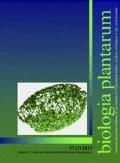Abstract
Supply of KNO3, NH4Cl or NH4NO3 to the maize seedlings increased total chlorophyll and carotenoids (over zero nitrogen control) amounts per fresh matter unit of the primary leaves. The increase was most apparent when the pigment level in control plants started declining,i.e. between days 14 and 16. Supply of inorganic nitrogen increased pigment synthesis in excised leaf segments from dark grown seedlings, although the increase during a 24 h incubation was not as high as with either glycine or glutamine. Salicylic acid at 0.01 to 1 mM concentration increased and at 10 mM lowered the pigment biosynthesis. The increase at lower concentrations of salicylic acid was unaffected by KNO3 but it was suppressed by NH4Cl. When 12-day seedlings were transferred to the dark, total chlorophyll and carotenoids declined appreciably, but the supply of inorganic nitrogen protected them from decline to same extent. Thus inorganic nitrogen, especially the nitrate, is more important in protecting from degradation of chlorophyll and carotenoids than in increasing their biosyntheses.
Similar content being viewed by others
References
Beale, S. I., Castblfbanco, P. A.: The biosynthesis of σ-ALA in higher plants 1. Accumulation of σ-ALA in greening plant tissues. - Plant Physiol.53: 291–296, 1974.
Bokhari, U. G.: The influence of stress condition on chlorophyll content of two rang grasses with contrasting photosynthetic pathways. - Ann. Bot.40: 969–979, 1976.
Bose, B., Srivastava, H. S.: Role of nitrate in delaying senescence of detached leaves. - Indian J. exp. Biol.17: 932–934, 1979.
Bose, B., Sbivastava, H. S., Mathttr, S. N.: Effect of some nitrogenous salts on nitrogen transfer and protease activity in germinatingZea mays L. seeds. - Biol. Plant.24: 89–95, 1982.
Chaudhury, N. K., Mahapatra, P. K.: Senescence ofCucurbita maxima cotyledons and effect of gibberellic acid and KNO3 on excised cotyledons. - J. indian Bot. Soc.56: 275–277, 1976.
Gancharyk, M. M., Urbanovich, T. A.: [Effect of nitrogen on the photosynthetic apparatus and photosynthesis of potato.] In Beloruss. - Vestsy Akad. Navuk belarus. SSR, Ser. biyal. Navuk1971 (1): 5–7, 1971.
Ikan, R.: Natural Products: A Laboratory Guide. - Acad. Press, New York 1969.
Jain, A., Srivastava, H. S.: Effect of salicylic acid on nitrate reductase activity in maize seedlings. -Physiol. Plant.51: 339–342, 1981a.
Jain, A., Srivastava, H. S.: Effect of salicylic acid on nitrite reductase and glutamate dehydrogenase activity in maize roots. - Physiol. Plant.53: 285–288, 1981b.
Knypl, J. S., Chylinska, M. M.: The inhibitory effect of (2-chloroethyl)—trimethyl ammonium chloride and its reversal by potassium. - J. exp. Bot.23: 525–529, 1972.
Peterson, J. B., Miller, C. O.: Cytokinins inVinca rosea crown gall tumour tissues as influenced by compounds containing reduced nitrogen. - Plant Physiol.57: 393–399, 1976.
Pooviah, B. W., Leopold, A. C.: Effect of organic salts on tissue permeabilitv. - Plant Physiol.58: 182–185, 1976.
Pork, Y., Morris, M. M., Mackinney, G.: On chlorophvll breakdown in senescent leaves. - J. agr. Food Chem.21: 279–281, 1973.
Resh, F. M.: Effect of mineral fertilizers on biosynthesis of pigments and glycosides in leaves ofDigitalis purpurea L. -Fiziol. Biokhim. kul’t. Rast.6: 198–200, 1974.
Romanova, E. T.: Cyclic photophosphorylation in barley chloroplast depending upon level of nitrogen metabolism. - Fiziol. Biokhim. kul’t. Rast.9: 473–478, 1977.
Shemin, D., Russel, C. S., Abramsky, T.: The succinate gfycine cycle 1. The mechanism of pyrrole synthesis. - J. biol. Chem.215: 613–618, 1955.
Sbivastava, H. S.: Some aspects of nitrate assimilation in the seedlings of normal and opaque-2 mutant of maize. - J. exp. Bot.27: 1215–1222, 1976.
Strain, H. H., Svec, W. A.: Extraction, separation, estimation and isolation of the chlorophylls. - In:Vernon, L. P., Seely, G. R. (ed.): The Chlorophylls. Pp. 21–66. Acad. Press. New York-London 1966.
Thomson, W. W., Weier, T. E.: The fine structure of chloroplast from mineral deficient leaves ofPhaseolus vulgaris. - Amer. J. Bot.49: 1047–1055, 1962.
Titu, H., Tanase, V.: Effect of nitrogen source on the ultrastructure of corn leaf chloroplast. - Stud. Cercet. Biol.27: 171–175, 1975.
Vesk, M., Possingham, J. V., Mercer, F. V.: The effect of mineral nutrient deficiency on the structure of leaf cells of tomato, spinach and maize. - Aust. J. Bot.14: 1–18, 1965.
Author information
Authors and Affiliations
Rights and permissions
About this article
Cite this article
Mishra, S.N., Srivastava, H.S. Role of inorganic nitrogen in the synthesis and degradation of chlorophyll and carotenoids in maize leaves. Biol Plant 25, 21–27 (1983). https://doi.org/10.1007/BF02878262
Received:
Accepted:
Issue Date:
DOI: https://doi.org/10.1007/BF02878262




